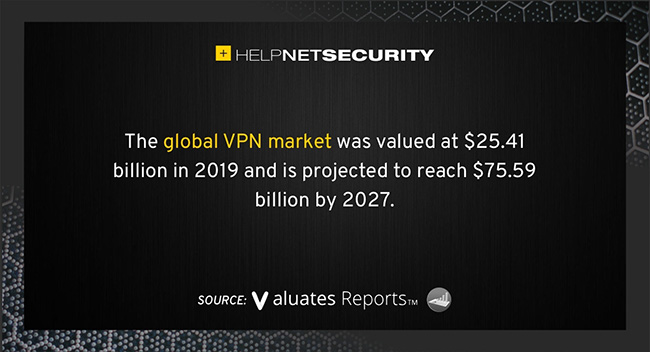Worldwide VPN market to reach $75.59 billion by 2027
The global VPN market was valued at $25.41 Billion in 2019 and is projected to reach $75.59 Billion by 2027, growing at a CAGR of 14.7% from 2020 to 2027, Valuates Reports reveals.

Major factors driving the growth of VPN market size, increase in data security concerns, rise in advanced & complex cyber threats, and an upsurge in usage of mobile & wireless devices within organizations.
This study includes the analytical depiction of the virtual private network market forecast and trends to determine the imminent investment pockets.
Trends influencing the VPN market size
The upsurge in usage of mobile and wireless devices is expected to drive the growth of the VPN market size. When more and more work transactions are performed by mobile devices, security is becoming a major concern. Mobile VPN technology and other mobile security products are considered key components as more mobile devices reach the workplace.
The VPN market size is rising as businesses implement BYOD policies to improve efficiency and reduce cost. The Private Network Tool ensures that remote staff is safely linked to corporate networks, thus shielding BYOD devices from malicious cyber-attacks.
The rise in advanced and complex cyber threats is expected to fuel the VPN market size. Cybercriminals have shown that they can easily take advantage of users communicating via hotspots or unsecured networks, although organizations have little protection against such attacks.
Hackers are actively searching for new vulnerabilities to exploit, and businesses need to be prepared for these zero-day attacks. The use of VPN and the compliance of mobile endpoint organizational policies help prevent these attacks.
COVID-19 impact on VPN market
As a result of COVID-19, businesses have already started to adjust their digital transformation priorities and concentrate on addressing shifts in network needs. VPN connections are important for workers when working remotely and are often the IT team’s first stage in enabling a virtual workforce.
For remote employees, the ability to access data at all times is critical. The ability to access the internet via improved wireless technology has allowed applications to be downloaded…


